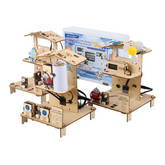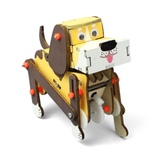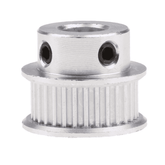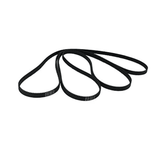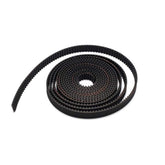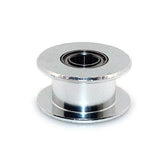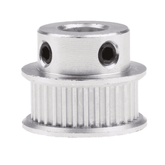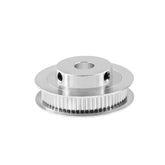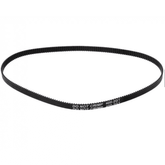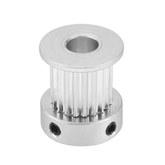-
GT2-6mm Belt Width 30 Teeth 8mm Bore Timing PulleyGT2-6mm Belt Width 30 Teeth 8mm Bore Timing Pulley GT2-6mm Belt Width 30 Teeth 8mm Bore Timing Pulley is the basic element of the system transmitting power to the moving parts of the machine. Some are made of high-quality aluminum. It will find its...
- Rs. 97
Rs. 149- Rs. 97
- Unit price
- per
Save Rs. 52 -
GT2 Rubber Timing Belt Closed Loop 6mm Width for 3D Printer CNC 6mm width and 610 mm longGT2 Rubber Timing Belt Closed Loop 6mm Width for 3D Printer CNC 6mm width and 610 mm long GT2 Rubber Timing Belt is a Closed-loop with 6mm width and 610 mm long used for generating linear motion, timing synchronization, torque & speed conversion, etc....
- Rs. 115
Rs. 169- Rs. 115
- Unit price
- per
Save Rs. 54 -
1 Meter x GT2 Open Timing Belt 6mm Width Pitch 2mm for 3D PrinterGT2 Open Timing Belt 6mm Width Pitch 2mm for 3D Printer The GT2 open timing belt is suitable for dishwashers, packaging machinery, motorcycles, automobile, dryer, food machinery, inkjet printer, conveyor, bonders etc.
- Rs. 83
Rs. 99- Rs. 83
- Unit price
- per
Save Rs. 16 -
GT2 Perlin Driven Aluminium Pulley - 6mm Belt 5mm BoreGT2 Perlin Driven Aluminium Pulley - 6mm Belt 5mm Bore The GT2 perlin driven pulley is manufactured with a strong aluminium alloy. They are produced with a bore diameter of 5mm. They are highly compatible with GT2 timing belt of 6 mm width. The pulley...
- Rs. 63
Rs. 99- Rs. 63
- Unit price
- per
Save Rs. 36 -
GT2 6mm Belt Width 20 Teeth 5mm Bore Timing PulleyGT2 6mm Belt Width 20 Teeth 5mm Bore Timing Pulley This is GT2-6mm Belt Width 20Teeth 5mm Bore Timing Pulley with 20Teeth, 5mm bore diameter. Aluminum 16T GT2 timing pulley has a high-quality shiny surface appearance and robust construction, longer working life. The rounded teeth...
- Rs. 29
Rs. 44- Rs. 29
- Unit price
- per
Save Rs. 15 -
GT2-6mm Belt Width 30 Teeth 5mm Bore Timing PulleyGT2-6mm Belt Width 30 Teeth 5mm Bore Timing Pulley GT2-6mm Belt Width 30 Teeth 5mm Bore Timing Pulley is the basic element of the system transmitting power to the moving parts of the machine. Some are made of high-quality aluminum. It will find its...
- Rs. 102
Rs. 155- Rs. 102
- Unit price
- per
Save Rs. 53 -
Openbuilds Smooth Idler Bearing Pulley H Groove WheelOpenbuilds Smooth Idler Bearing Pulley H Groove Wheel Rubber Bearing Pulley H groove Wheel is a motor grade 625 bearing. This pulley can be mounted in a variety of fashions to fit your design. It can be used in 3D printers and CNC engraving machines. There are a...
- Rs. 67
Rs. 89- Rs. 67
- Unit price
- per
Save Rs. 22 -
6mm Timing Belt 3D Printer Belt White GT2 Open Synchronous Belt PU with Steel Core -1 Meter6mm Timing Belt 3D Printer Belt White GT2 Open Synchronous Belt PU with Steel Core -1 Meter GT2 timing belts are a fantastic way to transfer rotational motion (from a stepper motor) in to linear motion and these GT2 belt are excellent for the...
- Rs. 50
Rs. 82- Rs. 50
- Unit price
- per
Save Rs. 32 -
Aluminum GT2 6mm Belt Width 60 teeth 5mm Bore Aluminium Timing PulleyAluminum GT2 6mm Belt Width 60 teeth 5mm Bore Timing Pulley This is GT2-6mm Belt Width 60 teeth 5mm Bore Aluminium Timing Pulley. Aluminum 60T GT2 timing pulley has high quality shiny surface appearance and robust construction, longer working life. he rounded teeth of this tooth...
- Rs. 132
Rs. 199- Rs. 132
- Unit price
- per
Save Rs. 67 -
GT2 Rubber Timing Belt Closed Loop 6mm Width for 3D Printer CNC 6mm width and 400 mm longGT2 Rubber Timing Belt Closed Loop 6mm Width for 3D Printer CNC 6mm width and 400 mm long GT2 Rubber Timing Belt is a Closed-loop with 6mm width and 400 m long used for generating linear motion, timing synchronization, torque & speed conversion, etc....
- Rs. 86
Rs. 104- Rs. 86
- Unit price
- per
Save Rs. 18 -
GT2-6mm Belt Width 16 Teeth 4mm Bore Timing PulleyGT2-6mm Belt Width 16 Teeth 4mm Bore Timing Pulley This is GT2-6mm Belt Width 16 Teeth 4mm Bore Timing Pulley with 16 Teeth, 4mm bore diameter. Aluminum 16T GT2 timing pulley has a high-quality shiny surface appearance and robust construction, longer working life. The rounded...
- Rs. 41
Rs. 99- Rs. 41
- Unit price
- per
Save Rs. 58 -
GT2-6mm Belt Width 20 Teeth 6.35mm Bore Timing PulleyGT2-6mm Belt Width 20 Teeth 6.35mm Bore Timing Pulley This is an Aluminum GT2 Timing Pulley 20 Tooth 6.35mm Bore For a 6mm Belt. For precise motion control, GT2 belts and pulleys offer excellent precision at a great price. This pulley is meant for use with GT2 6mm wide belts...
- Rs. 46
Rs. 59- Rs. 46
- Unit price
- per
Save Rs. 13

Best Price Guarantee

Ready Stock for Bulk Purchase

Dedicated Account Managers

5% GST Benefits for Eligible SEZ and Edu

Technical Support Available

1-Year Manufacturer Warranty



